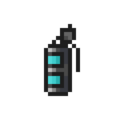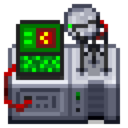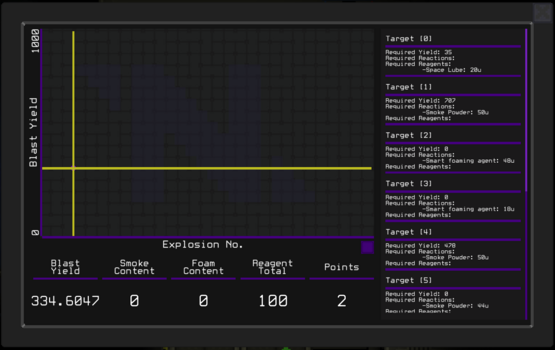Guide to Ordnance: Difference between revisions
No edit summary |
|||
| Line 1: | Line 1: | ||
Ordnance is the area of R&D focused on the synthesis of chemicals and explosives in particular, chemical grenades. If your goal as a scientist is to become and expert and not only creating potent explosives, but versatile explosives to not only protect the station but assist it, | Ordnance is the area of R&D focused on the synthesis of chemicals and explosives, in particular, chemical grenades. If your goal as a scientist is to become and expert and not only creating potent explosives, but versatile explosives to not only protect the station but assist it, then Ordnance is the area of Research for you. | ||
== Chemical Grenades == | == Chemical Grenades == | ||
Revision as of 07:10, 11 January 2024
Ordnance is the area of R&D focused on the synthesis of chemicals and explosives, in particular, chemical grenades. If your goal as a scientist is to become and expert and not only creating potent explosives, but versatile explosives to not only protect the station but assist it, then Ordnance is the area of Research for you.
Chemical Grenades

Chemical grenades are what you will be using for the vast majority of your ordnance adventures. In essence, all a chemical grenade is, is two beakers/chem storage containers attached to a timer that mixes them. Using a chemical grenade is simple:
1) Locate an empty chemical grenade casing or make one with 5 metal sheets.
2) Fill two beakers of any size with your desired chemicals
3) Place the beakers in the casing one after another
4) Use a screwdriver to secure the casing shut.
5) Active the grenade in your hand by either clicking on it while holding or pressing the 'Z' key.
6) Throw it!
After a short delay, the chemical grenade will mix the contents of the two beakers, if your chemistry is correct, this can cause an explosion, foam, smoke, or whatever you have designed it to do. If the grenade was not designed to explode, then it is possible that the casing survived, as such, it can be recovered, and by un-securing the casing with a screwdriver and removing the beakers, the casing can be resused for further testing.
Some simple chemical grenades include:
A) 1 beaker of Potassium. 1 beaker of Water. Upon mixing, creates a small but potent explosion.
B) 1 beaker of 50% Phosphorus 50% Sugar. 1 beaker of 50% Potassium 50% Delivered Chemical. Upon mixing, a smoke cloud will appear, laced with the delivered chemical. Can be applied to create healing smoke, pitch black blinding smoke, or toxic smoke or poison smoke, depending on the application.
C) 1 beaker of Fluorosurfactant. 1 beaker of Water. Upon mixing will coat the floor in slippery foam, if a third reagent is included in the mix, said reagent will lace the foam.
The Blast Yield Detector

The blast yield detector is how you turn a series of random explosives into RP that can help the station. The blast yield detector will detect any explosions that take place in a cone on front of it, recording their yield and chemical composition, reporting it to its GUI. However, the most important feature of the detector is its bounty list.
If you are constructing your own blast yield detector, ensure it is connected both to a valid APC for power and a research server of which it will transmit any data to and receive its targets.
Explosive bounties
At the start of each round, the blast yield detector will be populated with 15 explosive targets or bounties. Each bounty will have a Required Yield, List of Required Reactions and a List of Required Reagents. If the detector detects an explosion that satisfies the requirements of a target, the target will complete and award 15RP.
Required Yield: The explosive potency of the grenade. The target explosive must have a potency within +- 10% of the listed value. The yield of any explosive will be displayed in the BYD after it detonates. Learning what chemical mixes result in which yields can take alot of time an experimentation to learn, but once it is learnt, doing so can become a breeze.
Required Reactions: The required reactions are chemicals that must not be present in the grenade prior to mixing, but result from the mixing of the chemicals in the beakers. Most commonly, required reactions are various foams or smoke powder. The quantity of the final reactant must match exactly with the displayed value. Getting them to match exactly can take time and some math. Ordnance departments come equipped with eyedroppers which can be utilised to place very precise amounts of reagents into beakers.
Required Reagents: The required reagents are chemicals that must be present before and after the beakers mix. Similar to the required reactions, these reagents must be in the exact quantity specified in the target and as such, the departments eyedroppers can once again be used to obtain precise amounts of each chemical.
Once you have created a chemical grenade that you believe satisfies the requirement of a bounty, you must test it live. The grenade must be detonated in the view of the blast yield detector (Most stations come equipped with a Mass Driver or airlock for detonating explosives in space safely away from the station). If the grenade matches a bounty, that bounty will clear, and you will be awarded the RP.

Tips & Tricks
- Don't stress about putting all your reagents in the same beaker at first. If the explosive requires reagents like space lube, mix them separately before transferring them all to the final beaker.
- For required reactions, ensure they cannot react before the beakers mix. If you put potassium in one beaker, ensure no water is put in that same beaker, keep them separate until the grenade triggers.
- Using the Techweb, higher capacity beakers can be researched, these higher capacity beakers, such as meta material and bluespace beakers, can prove invaluable when creating larger or more complex grenades.
- Ordnance is one of the science departments that can benefit from multiple scientists collaborating, as most ordnance labs have enough equipment for two scientists to work simultaneously.
- To save time, employ the use of science goggles, science googles allow you to see the content of containers such as beakers when inspecting, saving you time having to place beakers back inside the chem dispenser to check their composition.
- Bounties don't have to be done in order! If you are more confident with some bounties over others, you can always knock out the easier ones first, then take your time with the harder ones later on.
- Bounties can amount to 225 RP throughout an entire round, this is a substantial portion of the Techweb from ordnance alone, if you are struggling to research the Techweb, don't neglect ordnance!
- Currently this wiki is incomplete, for recipes on chemicals, check out the TG wiki here
Mapping
If you are a developer planning on mapping an ordnance lab, make sure you can tick all the following boxes:
[ ] The department has a blast yield detector; the detector is facing in the correct direction and is properly connected to the research server.
[ ] The department contains some method of detonating explosives safely in the view of the BYD. This is often done with a mass driver, but other methods can be used as well.
[ ] The department has at least 2 Chem Dispensers, explore having upwards of 4 for larger stations.
[ ] The department is adequately equipped with beakers. At the bare minimum, at least 2 boxes of beakers should be present, Accompanied by at least 2 large beakers.
[ ] The department comes pre-equipped with at least 4 chemical grenade casings, and a screwdriver to tinker with them.
[ ] The department has a bomb suit locker for scientists to wear while testing, on larger maps, explore having up to 4 bomb suits.
[ ] The department has atleast 2 eyedroppers, consider having significantly more (Upwards of 4) for larger stations.
[ ] The department should have one bottle of toxin for specific bounties that require it. Be careful before adding more.
Command
|
|
Synthetic
|
|
Security
|
|
Engineering
|
|
Science
|
|
Medical
|
|
Cargo
|
|
Service
|
|
Central Command
|
|
Antagonist
|
|
Ghost
|